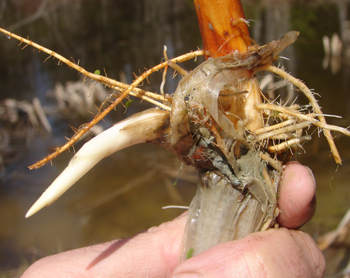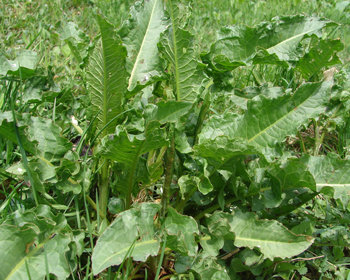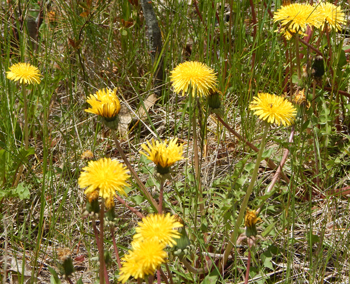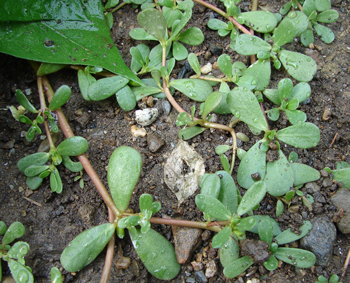Foragers Tap Into Nature’s Smorgasbord
by Tom Seymour

The first product from cattails grows underwater and is available in the early season. The dead stalks from last year’s cattails hold a surprise in the form of a white, curved, tapered shoot. This can be up to four or five inches long and after rinsing in clean water may be eaten raw, used in salads or as a stir-fry ingredient. Tom Seymour photo.
Simply put, foraging is the act of obtaining food from the wild. But there’s far more to it than that. Foraged foods, wild plants in particular, out-compete their domestic counterparts in nutritive value. Wild plants contain more vitamins than cultivated crops. In addition, wild plants contain no pesticide residue. And for those seeking to eat more organic products, wild plants put the “O” in organic.
Universally Abundant
Woods, fields, streamsides, lawns and even vacant lots all are home to edible, wild plants. Even better, edible, wild plants become available only days after snow melts and the top few inches of ground thaw. The bounty continues, unabated, until the first killing frost. And even then, some wildlings remain available for our use.
Many common wild plants fall under the “potherb” category. This term applies to any leafy, green plant that we prepare by boiling, simmering or steaming in water. But potherbs are just one type of edible, wild plant. Other varieties include root crops, stems, unopened and opened flower clusters, nuts and berries.
Here we are in early summer, so let’s take a look at what is available to foragers right now. To begin, we’ll discuss common cattails.
Cattails
Wild plants contain
more vitamins than
cultivated crops.
Common cattails, Typha latifolia, offer a number of food products. Fortunately, cattails rank among the most widely available of edible, wild plants, growing along streamsides, shallow ponds, wetlands and even roadside ditches.
The first product from cattails grows underwater and is available in the early season. The dead stalks from last year’s cattails hold a surprise in the form of a white, curved, tapered shoot. This can be up to four or five inches long and after rinsing in clean water may be eaten raw, used in salads or as a stir-fry ingredient. It has a rich, nutty flavor.
Next, the young stalk of cattails has an edible core. To use, cut as close to the water as possible and peel off the outer layers to reveal the inside core. This may be eaten sans washing because it is on the inside of the plant. Use cattail stem cores cut-up in stir-fries or simply eat them raw.
In July, when the seedheads, the “cattail” part, develop, we can enjoy them as ersatz “corn on the cob.” Just cut the stalk below the green seedhead and place in a cloth bag or basket. Don’t use plastic bags to hold foraged foods because they make the plants sweat, which leads to spoilage.
Clouds of pollen
will fall in the bag.
In this way it is
possible to pick many
pounds in only a
few minutes.
To determine if the seedheads are ready to pick, try to crumble it with your thumbnail. If the seedhead crumbles easily it is prime. But if your nail barely makes a dent, wait a few more days before picking. After harvesting a good supply, take them home and boil in water the same as corn on the cob. After cooking for perhaps 10 minutes, drain and serve with butter, salt and pepper. And eat like corn on the cob, twisting the seedhead as you go. These are worth preserving for future use. Just blanch for two minutes, drain, cool and place in freezer bags.
Finally, once the seedheads mature, they become coated with a yellow pollen. This is easily harvested by holding the pollen-ripe seedhead over an open paper bag and tapping with your finger. Clouds of pollen will fall in the bag. In this way it is possible to pick many pounds in only a few minutes.
Cattail pollen is used in baking, either straight or mixed with wheat flour. A half-pollen, half-wheat flour muffin has a rich, nutty taste and an attractive yellow color. I like cattail pollen mixed with pancake batter for a wild pancake breakfast.
Curled Dock

Curled dock, or “curly dock,” Rumex crispus, is a three-foot-tall plant with long, tapered, wavy leaves. The leaves make an excellent potherb. Tom Seymour photo.
Curled dock, or “curly dock,” Rumex crispus, is a three-foot-tall plant with long, tapered, wavy leaves. The leaves make an excellent potherb. Pick young leaves and after rinsing, briefly steam or simmer in water only until they turn color and become limp when lifted with a fork. Drain and serve with your favorite seasonings.
While most wild, edible plants are only prime for about two weeks, curled dock remains good all summer and even into fall. The plant continues to push new growth all season and it is these young leaves that foragers seek.
Curled dock grows in damp locations and that includes edges of lawns and roadside ditches. Dock also grows just above the high-tide line along the seashore, making it available to everyone.
Curled dock belongs in the buckwheat family, as evidenced by its three-sided seeds.
Dandelion Blossoms

Many homeowners fight dandelions and go out of their way to eradicate them. But dandelions rank among the finest of wild foods, not only in taste but in vitamin content. Prior to refrigeration, country people eagerly headed to nearby fields to harvest dandelions. They knew that after a long winter of salted and canned foods, that their bodies needed the vitamins provided by fresh dandelions. Tom Seymour photo.
So many homeowners fight dandelions, Taraxacum officinale, and go out of their way to eradicate them. But dandelions rank among the finest of wild foods, not only in taste but in vitamin content. Prior to refrigeration, country people eagerly headed to nearby fields to harvest dandelions. They knew that after a long winter of salted and canned foods, that their bodies needed the vitamins provided by fresh dandelions.
Everyone is familiar with dandelion leaves as a potherb. But when the plant flowers, the leaves become too bitter to be palatable. Instead of writing dandelions off, though, it’s time to collect the yellow flowers for a totally different dish. Batter-fried dandelions can serve as the main course for any meal. They are that good.
Just pick the blossoms and check for any clinging debris or insects and then dip in a batter and fry. Choices of batter vary and I’ve even used commercially made pancake batter to good effect. Tempura batter works especially well for this. Just dip in batter until fully coated and fry in a frying pan. There’s no need to deep-fry, either. Instead, just fry in oil or butter substitute (I use Olivio, a product made with vegetable and olive oil), the same as if you were frying up a fish fillet.
Fry until the blossoms turn golden brown and then place on a paper towel to dry. Even those who are not fond of vegetables enjoy fried dandelion blossoms, so make more than you think you’ll use, because they will surely disappear quickly.
Purslane

Purslane tastes remarkably good raw, so use it as a convenient nibble. But it really shines as the main ingredient of a stir-fry. Purslane has a mucilaginous quality and this reflects its Omega 3 content. Tom Seymour photo.
Purslane, Portulaca oleracea, a common garden, “weed,” ranks among the most tenacious and difficult weeds to eradicate. Once established in a garden, this self-seeding plant will never go away. So it’s fortunate that it is not only edible, but also delicious.
Purslane is a vining plant with paddle-shaped leaves. The top of each leaf is shiny green, and the bottom is whitish and has a kind of grainy powder, which is easily washed off. The vines are succulent, with a high water content.
If left unchecked, purslane will easily take over any garden bed. The best way to pick it is to pull each plant up by the roots. However, this won’t get rid of it because purslane self-seeds readily and the seeds are already in the ground.
So pick all you can use and take home and rinse thoroughly to remove any fine grit. After this, purslane has several uses. First, it tastes remarkably good raw, so use it as a convenient nibble. But it really shines as the main ingredient of a stir-fry. Purslane has a mucilaginous quality and this reflects its Omega 3 content.
Some foragers enjoy pickeled purslane stems. Try pickling in the same solution you would use for dilly beans.
The plants described here only represent a small fraction of the healthful, tasty wild plants available everywhere. To further pursue this topic, make sure to buy a good guidebook to edible, wild plants. You’ll be glad you did.
